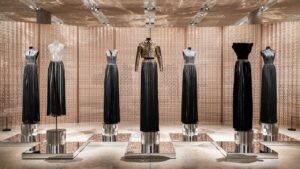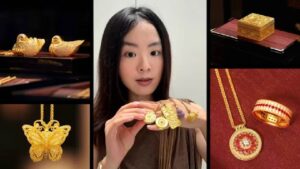A Childhood Dream Woven into Couture Legacy
PetitePaulina – In June 1956, a young Azzedine Alaïa stepped into the house of Christian Dior for a brief internship. Although he stayed only five days, those moments changed his entire life. From the very first hour, he sensed a different world one built with patience, talent, and discipline. As he watched the artisans at work, he absorbed every stitch with wonder. Consequently, this early encounter planted a deep admiration for Dior’s vision. Over time, that admiration grew stronger, eventually shaping Alaïa into one of fashion’s most devoted couturiers. He later collected Dior pieces not for fame but for affection. Now, after years of quiet preservation, his archive finally opens to the public. Through this exhibition, visitors can see how a short experience can evolve into a powerful legacy that still speaks today.
A Historic Dialogue Between Two Masters
Walking into La Galerie Dior feels like entering a conversation where Dior and Alaïa exchange ideas through fabric. As visitors move through the rooms, they sense a shared language of precision and elegance. This exhibition, curated by Olivier Saillard and Gaël Mamine, intentionally highlights their connection. It also marks the first time Dior presents a collection it does not own. Therefore, the show stands as a tribute to Alaïa’s loyalty to the house. Each garment reveals how Dior shaped Alaïa’s understanding of structure, and how Alaïa later refined that influence in his own work. As a result, the gallery holds a unique emotional charge. Every silhouette reflects the respect each man had for the female form. Ultimately, this exhibition becomes a dialogue across generations, built not with words but with craftsmanship.
“Read More : A New Era of Bravery and Breakthroughs in Beauty”
The Unveiling of a Long-Kept Secret Archive
For decades, Alaïa protected his Dior collection like a treasured secret. He collected each piece quietly and with intention, never seeking recognition. Eventually, Dior Heritage uncovered the vast archive and its surprising scale. Inside the foundation, they found more than 600 garments, many unseen by the public. In addition, they discovered sketches, clippings, and atelier notes that revealed Dior’s creative process. Cataloging these items became a slow and thoughtful effort. Step by step, the team uncovered a hidden narrative woven through decades. Today, the exhibition finally brings that narrative forward. Each piece shows Alaïa’s respect for the past and his dedication to preserving beauty. Consequently, visitors can now witness not only Dior’s genius but also Alaïa’s commitment to memory, culture, and craft.
The Hidden Architecture Linking Two Couturiers
Alaïa often explained that Dior’s dresses reminded him of buildings. They seemed strong, balanced, and full of structure. Because of this early admiration, he studied Dior’s silhouettes throughout his life. In the exhibition, visitors can clearly see this influence. Dior’s geometric lines from Ligne Ailée to Ligne Fuseau stand like sculptural forms. Meanwhile, nearby pieces from Alaïa echo the same architectural precision. This placement is intentional, allowing the dialogue between the two designers to unfold naturally. Additionally, the pairing helps viewers understand how fashion becomes a language of shape and proportion. Although each designer had a distinct voice, they shared a deep respect for the body as a foundation of design. Ultimately, the room reveals how structure can express emotion, turning engineering into art.
“Read More : Loewe Welcomes Song Kang as Its Newest Global Face”
A Softer Dior Through Alaïa’s Eyes
Beyond the structured silhouettes, the exhibition also reveals Dior’s gentler side. This section bursts with color, embroidery, and playful patterns. Alaïa chose these pieces with great affection because they showed Dior’s romantic spirit. For instance, dresses in bright red, soft pink, and lively blue fill the room with warmth. Moreover, delicate floral embroidery creates an atmosphere of joy. The “Fête au Village” dress from 1955 becomes a highlight with its light and airy details. Through these choices, Alaïa shows that he admired not only Dior’s precision but also his tenderness. As visitors walk through this space, they can sense the emotional energy behind the designs. Ultimately, this room reveals a Dior who honored beauty with softness, and an Alaïa who understood that emotion is as important as structure.
Preserving Legacy as a Museum of Emotion
Today, the Azzedine Alaïa Foundation is working toward becoming an official museum. Although the process takes time, the spirit of a museum already lives within its walls. Every garment is treated with care, as if it carries a fragile memory. This thoughtful approach reflects Saillard’s dedication to preservation. Dior’s original employee card for Alaïa is displayed quietly, marking the brief moment their paths crossed. Additionally, the surrounding pieces form a story of admiration and discipline. Through this exhibition, visitors can see how fashion becomes a record of hopes and dreams. It also shows that preserving history is a form of love. Ultimately, Alaïa’s archive stands as proof that beauty endures when someone chooses to protect it.













